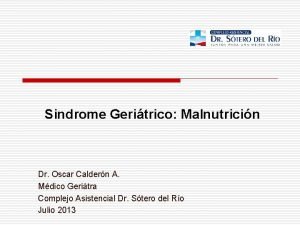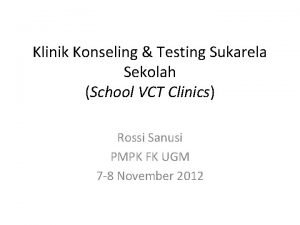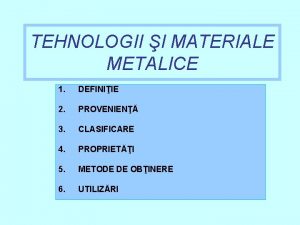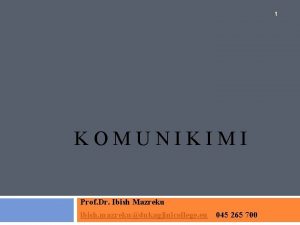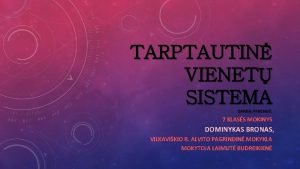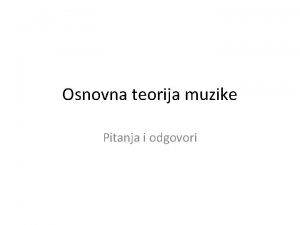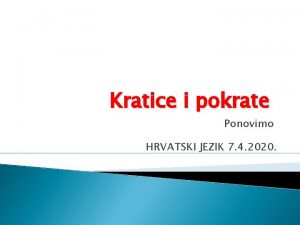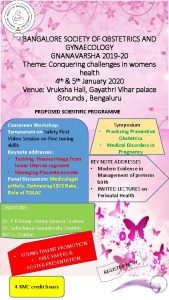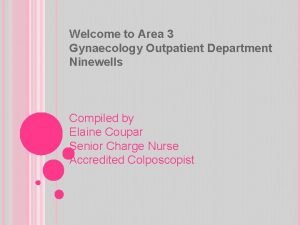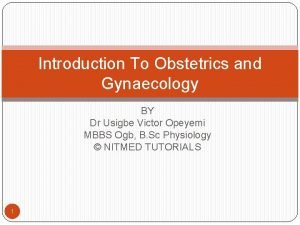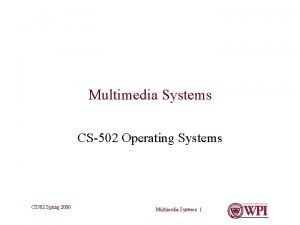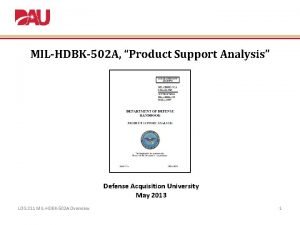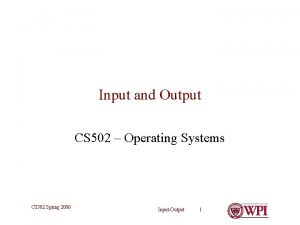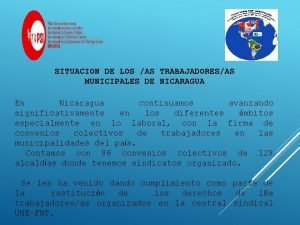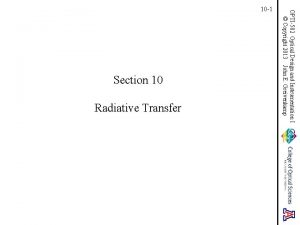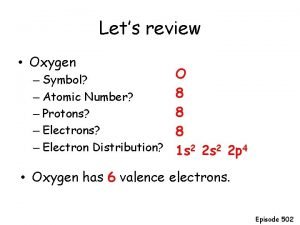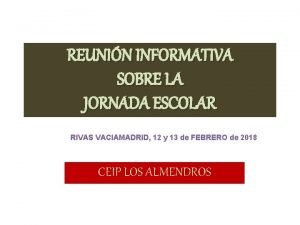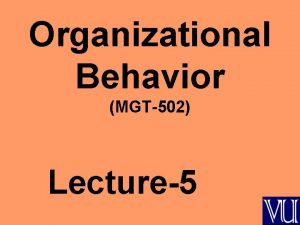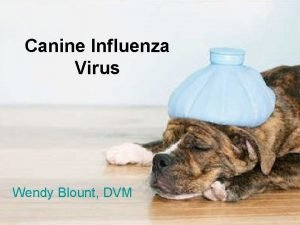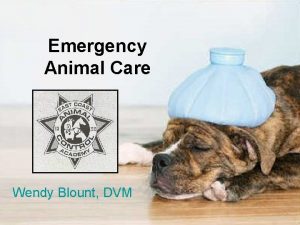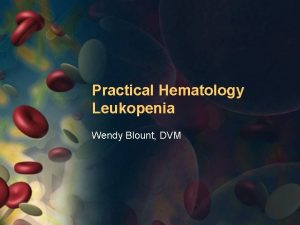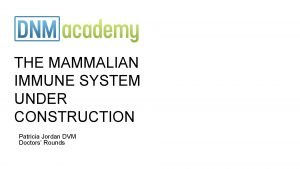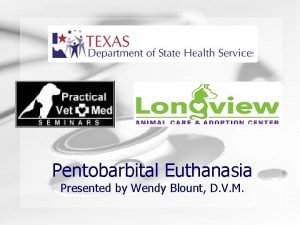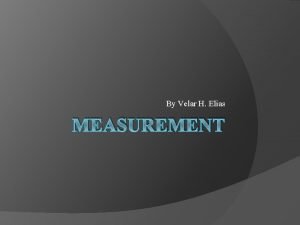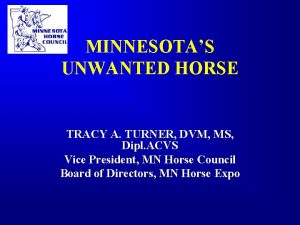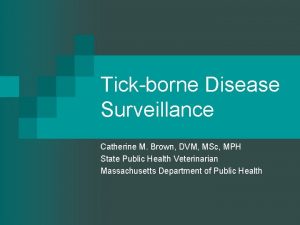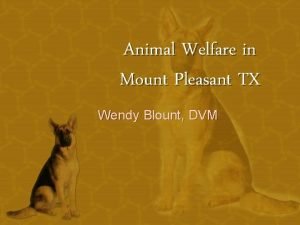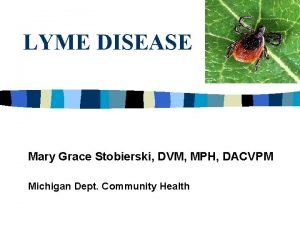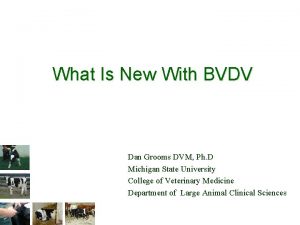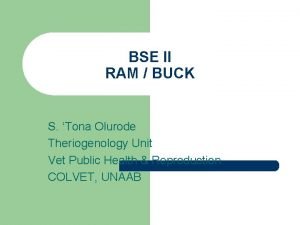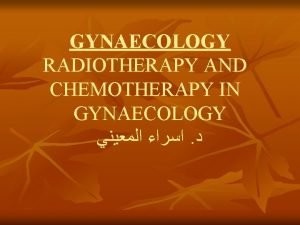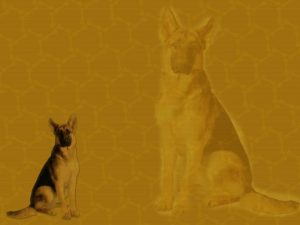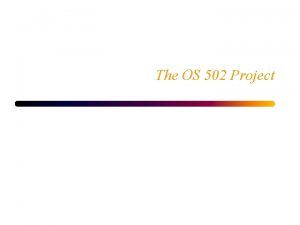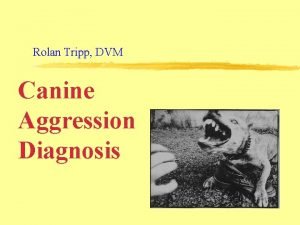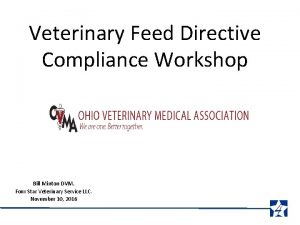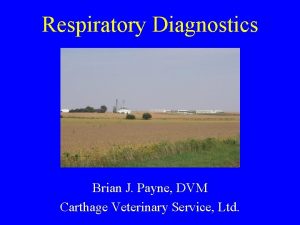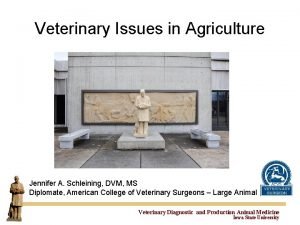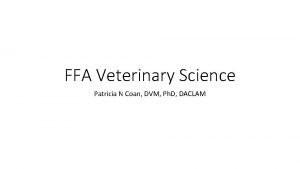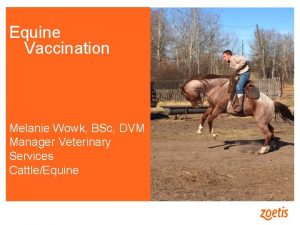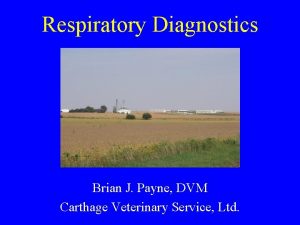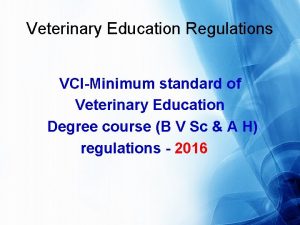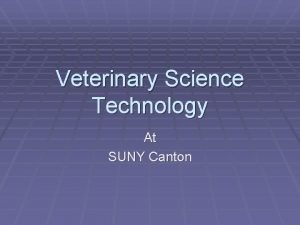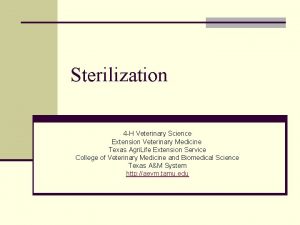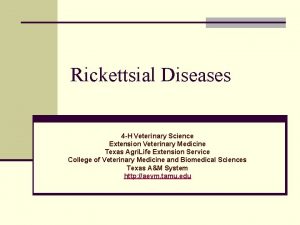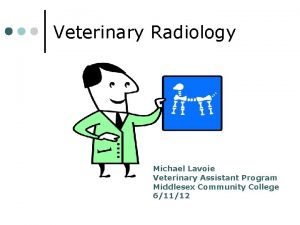Veterinary Gynaecology VCT 502 S Tona Olurode DVM














































- Slides: 46

Veterinary Gynaecology VCT 502 S. ’Tona Olurode DVM, MVSc. (Theriogenology) Dept. of Vet. Public Health&Reprod. College of Vet. Medicine, UNAAB 11/25/2020 1

Learner’s objectives n n n n n Define the basic concepts and terminologies in Theriogenology Review the normal anatomy and physiology of the female domestic species Carry out comparism of the reproductive features Define and Describe placentation Define pelvimetry and conceptualize its importance Discuss female reproductive hormones State the various hormones of female reproduction and their functions Define steroidogenesis Define Puberty and explain factors associated with its onset 11/25/2020 2

INTRODUCTION TO THERIOGENOLOGY Definition: term derived from 3 Greek words- Therion beast Genan - to produce Logus - study of 11/25/2020 3

Introduction contd’ n Theriogenology can be defined as that branch of Veterinary Medicine which deals with reproduction, including the physiology and pathology of male and female reproductive systems and the clinical practice of veterinary obstetrics, gynaecology and semenology. 11/25/2020 4

Veterinary Gynaecology n that branch of medicine which treats diseases of the genital tract in the female. 11/25/2020 5

Veterinary Obstetrics n It is that branch of veterinary science which deals with the necessary or advisable aid during the act of parturition in all animals coming under the purview of the veterinarian. It is the art of managing cases of animal birth. It is that branch of surgery which deals with the management of pregnancy, labour and puerperium (the period from the end of the 3 rd stage of labour till completion of uterine involution). 11/25/2020 6

Anatomical review of female reproductive tract: The Pelvis n n The pelvis is the smallest and most posterior of the three great cavities of the trunk, and is of considerable importance to the obstetrician on account of its rigid wall, and the resulting resistance which it presents to the passage of the fetus as a result of any variation from the normal. The attachment of the vulva to the pelvis constitutes the only fixed base of support for the vagina, cervix, and the uterus. This attachment enables the uterus at the time of parturition, to contract longitudinally in a manner which aids in dilating the birth canal and forcing the foetus towards the vulva. 11/25/2020 7

Review contd’ n n n Pathologically, the pelvis is of limited interest in veterinary obstetrics as compared with human obstetrics. The quadrupedal position of the domestic animal largely relieves the pelvis of weight-bearing, thus preventing deformities from pressure upon diseased pelvic bones, and as such renders pelvic deformities comparatively rare. The pelvis is formed by both bony and ligamentous structures. The bony pelvis is bounded at the sides and below by the two coxae and above by the sacrum and first three coccygeal vertebrae. 11/25/2020 8

Review contd’ The os coxae each consists of an ilium, ischium and pubis. These paired bones form the chief boundary of the pelvis and the framework of the uppermost segment of the hindlimbs which it connects with the spine. n The Sacrum: Consists of a series of five fused vertebra in the horse and ruminants, four in the pig, and three in carnivora. 11/25/2020 9 n

Review contd’ The ligamentous portion of the pelvis consists of: (i) The dorsal and lateral sacro-iliac ligaments (ii) The sacro-sciatic ligament n 11/25/2020 10

Functions of the Sacro-Sciatic Ligaments: n n furnish attachments for the vulva and gluteal muscles prevent the posterior portion of the pelvis or ischia from rescinding from the sacrum. form a strong, flexible, and yielding wall to the pelvic cavity. Under pressure of parturition, they yield sufficiently to allow the constricted pelvic outlet to equal in dimensions the larger bony inlet of the pelvis. 11/25/2020 11

Articulation of the Pelvis There are five (5) pelvic articulations: 1. Sacro-lumbar 2. Right sacro-iliac 3. Ischio-pubic symphysis 4. Sacro-coccygeal 5. Left sacro-iliac These articulations are important in obstetrics because they become flexible at the time of parturition. n 11/25/2020 12

Pelvimetry n In all species, the pelvic inlet is roughly oval in shape with the sacro-pubic diameter being the largest. The sow and cow have the most elliptical pelvic inlets while the mare and some dogs have inlets that are nearly rounded. 11/25/2020 13

Pelvimetry contd’ n The term pelvimetry refers to the measurement of the dimensions of the pelvic cavity. In human obstetrics, pelvimetry has been a routine part of the prenatal management of the expectant mother to determine ease of delivery. This procedure was given very little attention in veterinary obstetrics until the last decade. At the present time there is a great deal of interest in pelvimetry and the information obtained is being utilized to reduce the incidence of dystocia in heifers of beef breed. 11/25/2020 14

methods used in determining the dimensions of the pelvic cavity: n 1. External or indirect pelvimetry is carried out by calculating the pelvic diameter based on measurements taken between the angles of the ilia, the distance between the ischia and the height from the hip joint to highest point of the croup. In general, this method has been shown to be inaccurate and is no longer used. 11/25/2020 15

Methods of pelvimetry n 2. Internal or direct pelvimetry refers to the measurement of the interior of the pelvis through the rectum with a pelvimeter. 11/25/2020 16

Pelvimetry procedure n The general procedure is to restrain the animal in a chute with light squeeze. A comfortable normal standing position is the best. Faeces should be removed from the rectum and the instrument carefully inserted into the rectum with the hand arm to the pelvic inlet. 11/25/2020 17

FEMALE REPRODUCTIVE SYSTEM n The female reproductive system consists of the ovaries and the female duct system. The duct system includes the oviducts (fallopian tube/uterine tubes), uterus, cervix, vagina and vulva. The ovaries originated from the secondary sex cords of the genital ridge while the duct system arose from the mullerian ducts (a pair) which appear during early embryonic development. 11/25/2020 18

Ovarian shapes in female animals n n The ovary of the cow is almond-shaped, but the shape is altered by growing follicles or corpora lutea. The average size is about 35 x 25 x 15 mm which is larger in cows with active ovaries than those with inactive ovaries. The ovaries of ewe and doe are almond-shaped and less than half the size of that of the cow. The ovaries in the mare kidney (or bean)-shaped and are two or three times larger than those for cows. The ovaries in the sow are slightly larger than those found in the ewe and appear as a “cluster of grapes”. 11/25/2020 19

UTERUS Four basic types of uteri are found in animals viz: n Bicornuate n Duplex n Simple n Bipartite 11/25/2020 20

11/25/2020 21

11/25/2020 22

11/25/2020 23

11/25/2020 24

11/25/2020 25

Placentation n The endometrium provides a mechanism for attachment of the extra-embryonic membranes. This union forms the placenta through the process called PLACENTATION which aids in the transport of nutrients from the maternal blood to embryonic or foetal blood as well as waste product removal from the foetal blood through the maternal systems. The nature of the placental attachments differs among species. Chorionic villi from the extra-embryonic membranes penetrate into caruncles which are button-like projections on the endometrium. This union forms the PLACENTOME. 11/25/2020 26

Placentation-classification n n The placental attachment of the mare, sow, doe, ewe and cow is classified as epitheliochorial. In humans and monkey, it is haemochorial. In dog and cat, it is classified as endotheliochorial whilst in rat, rabbit and guinea pig, it is classified as haemoendothelial. 11/25/2020 27

Placentation 11/25/2020 28

11/25/2020 29

11/25/2020 30

FEMALE REPRODUCTIVE HORMONES n Hormones are molecules that function as a message carrier within an organism, its only function is to convey information. Hormones are chemical agents which are carried by the blood to cells within a target organ of other target cells where they regulate a specific physiological activity. 11/25/2020 31

1) Endocrine glands: Don't have ducts. Secrete hormones internally into blood stream. 2) Exocrine glands: Have ducts. Secrete externally into ducts. Definition of Hormones: Chemical agents which are carried by the blood to cells within a target organ or other target cells where they regulate a specific physiological activity. Definition of Receptor sites: 1) Recognition units in cells that have a high affinity for a particular hormone 2) Chemically: Protein 3) Hormone + receptor site: initiates reactions within cell which bring about the specific physiological response within that bound hormone. 4) Location of receptor sites in a cell: Cytosol receptor: For steroid hormones Membrane receptor: For peptide or protein hormones 5) Concentration of receptor sites in a target organ: increase or decrease depending on the endocrine status of the animal. 11/25/2020 32

Hormone - Chemical messenger produced by a ductless gland or tissue and carried in the blood to a target organ where it effects a change in cellular activity. Functionally; reproductive hormones are classified into: Primary hormones: regulate the various reproductive processes Metabolic hormones: which indirectly influence reproduction. 11/25/2020 33

Classification According to their Chemical Structure Proteins: *Are Polypeptide hormones, *M. W=300 -70, 000 Daltons. *Because they are easily digested by enzymes, they cannot be given orally, but must be administrated by injection. Steroids: *M. W. =300 -400 Daltons. *Natural steroids are not effective by oral administration, but synthetic or plant steroids can be administrated orally and by injection. Fatty Acids: *M. W. = 400 Daltons *Can be administrated only by injection. 11/25/2020 34

Hormones that Regulate Reproduction: Hypothalamus Hormone Chemical Class Principal Functions Gonadotropin Releasing Hormone (Gn. RH) Peptide FSH & LH release Prolactin Inhibiting Factor (PIF) Peptide Prolactin Retention Prolactin Releasing Factor (PRF) Peptide Prolactin Release Corticotropin Releasing Hormone (CRH) Peptide ACTH release 11/25/2020 35

Hormones that Regulate Reproduction: Anterior Pituitary Hormone Chemical Class Principal Functions Follicle Stimulating Hormone) (FSH Protein Follicle Growth Estrogen Release Spermiogenesis Luteinizing Hormone (LH) Protein Ovulation CL formation & function Testosterone Release Prolactin Protein Milk Synthesis Adrenocorticotropin (ACTH) Polypeptide Release of Glucocorticoids Posterior Pituitary Oxytocin Synthesis in Hypothalamus Peptide Parturition Milk Ejection 11/25/2020 36

11/25/2020 37

11/25/2020 38

STEROIDOGENESIS The two cell steroid production theory states that: n Theca cells produce androgens under the influence of Luteinizing hormone while n Granulosa cells convert the androgens to oestrogens under the influence of FSH. 11/25/2020 39

PUBERTY IN FEMALE ANIMAL n It is defined as the achievement of the ability to reproduce or attainment of sexual maturity. It is the ability of an animal to release gametes and manifest complete sexual behaviour sequence. Irrespective of the mechanism, the attainment of sexual activity is a gradual process which is not a single event and occurs over a period of time. 11/25/2020 40

Puberty contd’ The onset of sexual activity is associated with decreased sensitivity of the hypothalamo-hypophyseal axis to negative feedback control of the gonadal steroids. n In the prepubertal animal, the hypothalamo-hypohyseal axis is very sensitive to low levels of the gonadal steroids 11/25/2020 41 n

Puberty contd’ n This decrease in sensitivity to negative feedback of gonadal steroids i. e. allowing higher levels of gonadotrophins (FSH and LH) required for cyclicity results in the initiation of PUBERTY – this is termed “GONADO STAT” theory. 11/25/2020 42

Age of puberty n n n n Bitch: Cow: Dow: Ewe: Mare: Queen: Sow: 11/25/2020 6 – 20 months 7 – 18 months 4 – 8 months 6 – 15 months 1 – 2 years 7 – 12 months 6 – 8 months 43

FACTORS AFFECTING THE TIME OF ONSET OF PUBERY n n n Genotype Nutrition Season of the year Proximity of the male animal Environment 11/25/2020 44

Nutrition n n Very important factor especially in the ruminants Generally occurs when 55 -65% adult body weight is attained 11/25/2020 45

n n Thank you all for your attention and patience Do you have question (s)? 11/25/2020 46
 Vct nutricion
Vct nutricion Vct school
Vct school Vct nutricion
Vct nutricion Foetotomy
Foetotomy Vct phase 2
Vct phase 2 Metal dur cenusiu cu luciu metalic
Metal dur cenusiu cu luciu metalic Si ti shprehim pikpamjet tona
Si ti shprehim pikpamjet tona 1 tona kiek centneriu
1 tona kiek centneriu Apakah warna penggenap
Apakah warna penggenap Bas kljuc lestvica
Bas kljuc lestvica Pokrate i kratice
Pokrate i kratice Bangalore society of obstetrics & gynaecology
Bangalore society of obstetrics & gynaecology Ninewells gynaecology assessment unit
Ninewells gynaecology assessment unit Harbourside gynaecology centre
Harbourside gynaecology centre Introduction to obstetrics and gynaecology
Introduction to obstetrics and gynaecology 5776-855
5776-855 Cs 502
Cs 502 Krs156.502
Krs156.502 502-026-050
502-026-050 Mil-hdbk-502a
Mil-hdbk-502a Cs 502
Cs 502 502
502 Ley 502 nicaragua
Ley 502 nicaragua Opti 502
Opti 502 Valence electron of oxygen
Valence electron of oxygen 502
502 Section 502 guaranteed rural housing loan program
Section 502 guaranteed rural housing loan program Ceip los almendros rivas
Ceip los almendros rivas Mgt502 business communication
Mgt502 business communication Krs156.502
Krs156.502 Cistache
Cistache Wendy blount
Wendy blount Wendy blount dvm
Wendy blount dvm Wendy blount
Wendy blount Patricia jordan dvm
Patricia jordan dvm Canine lateral saphenous vein
Canine lateral saphenous vein Roger clemmons dvm
Roger clemmons dvm Speuter
Speuter Integrating type dvm
Integrating type dvm Dr tracy turner
Dr tracy turner Dvm valuation method
Dvm valuation method Dvm sap
Dvm sap Catherine brown dvm
Catherine brown dvm Wendy blount
Wendy blount Dvm mph definition
Dvm mph definition Roger clemmons dvm
Roger clemmons dvm Patrick sullivan dvm
Patrick sullivan dvm
